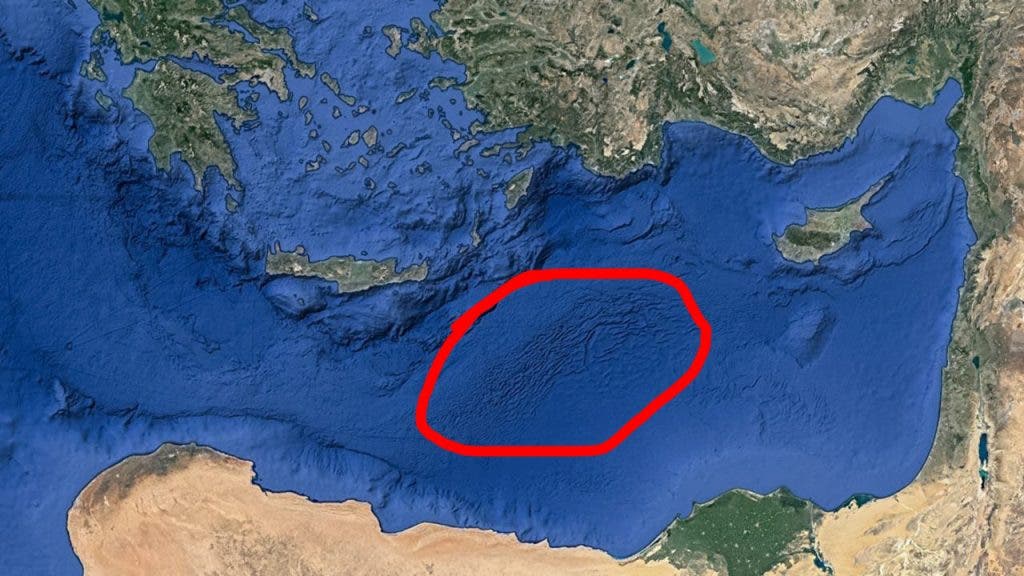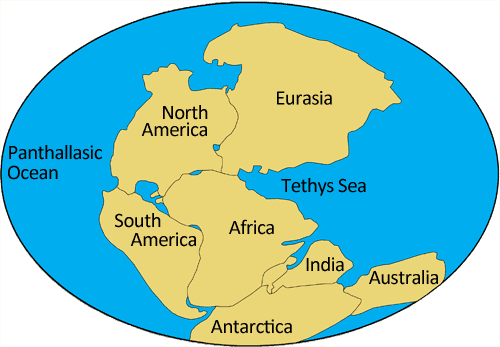
Credit: Google Earth
It’s hard to think we’re talking about the same planet when we see snapshots of Earth’s geological past. Powered by plate tectonics, the Earth’s crust and continents are constantly changing, shifting, losing and adding material through a host of geological processes. It’s amazing, though, that scientists are able to piece together the geological past and, in doing so, enrich our history and pinpoint our place in nature — one species that’s been alive for only 0.0022 percent of the time this planet has been around.
One of the most groundbreaking geological findings involves an ancient slab of sea floor beneath the East Mediterranean Sea which Roi Granot, a professor at the Ben Gurion University in Israel, says is up to 340 million years old. It’s the oldest yet and by far, being 70% older than any other known oceanic crust ever discovered. Around that time, the world’s landmasses were coming together to form the supercontinent Pangea.
Granot and colleagues towed magnetic sensing equipment on a special vessel which they used to survey the Mediterranean Sea for geophysical anomalies between October 2012 through October 2014. In these two long years, the researchers gathered 7,000 km worth of marine magnetic profiles across the Herodotus and Levant Basins, eastern Mediterranean.
The researchers were specifically on the watch out for oceanic crust since they knew they might find something beneath the thick layers of sediments which could be eight kilometers thick. Obviously, you can’t drill or ‘fish’ for rocks. Instead, modern geophysical methods enable researchers to use magnetic anomalies as proxies to build snapshots as if the oceanic crust was laid bare in front of them.
These magnetic anomalies are the signatures of magnetic minerals in rocks trapped in the oceanic crust, formed undersea by volcanic ridges. As the magma cools, the newly formed minerals in the rocks become magnetized and aligned with the direction of Earth’s magnetic field.
“Changes in the magnetic field’s orientation over time are recorded in the ocean floors, creating a unique barcode that provides a time stamp for crust formation,” Dr. Granot says. “The results shed new light on the tectonic architecture and evolution of this region and have important implications on various geodynamic processes.”
Eventually, Granot identified a pattern of magnetic anomalies like magnetic stripes — the hallmark of oceanic crust formed at a mid-ocean ridge. This led him to believe that the ancient crust he and colleagues had just discovered in the Herodotus Basin is 340 million years old. For comparison, all the other oceanic crusts are no older than 200 million because their high density typically pulls them back down in the mantle through subduction zones where they get recycled. What’s more, the team speculates that the slab might have once belonged to the long lost Tethys Ocean — an ocean that existed during much of the Mesozoic Era, before the Indian and Atlantic Oceans appeared during the Cretaceous Period.
“The area is covered by thick sedimentary coverage, making it unclear precisely how old the crust is and whether it is even oceanic at all,” Dr. Granot says. With the new geophysical data, we could make a big step forward in our geological understanding of the area.”
If Granot’s assumption about the Herodotus crust and the Tethys Ocean is correct, then Tethys could have formed at least 50 million years earlier than thought.
Ref: Palaeozoic oceanic crust preserved beneath the eastern Mediterranean, Nature Geoscience, nature.com/articles/doi:10.1038/ngeo2784










